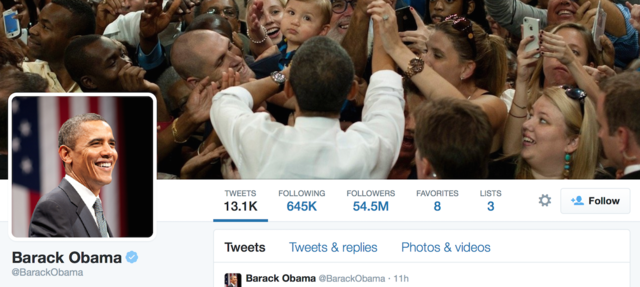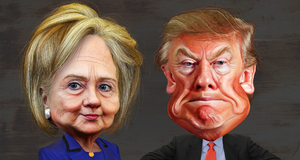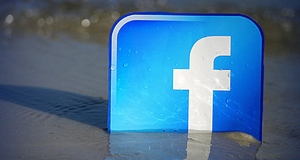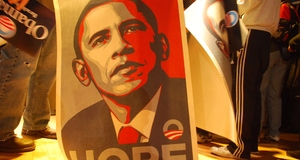The Obama PresidencyE-Electioneering: The Political and Cultural Influence of Social Media in the 2008 and 2012 Presidential Elections
By
2015, Vol. 7 No. 02 | pg. 1/4 | »
IN THIS ARTICLE
KEYWORDS
Early in 2007, a junior senator with a thin legislative résumé but an inspiring background in community organizing approached a Facebook executive during the site’s period of exponential growth. That senator, later known as our 44th President, was gearing up to embark on his own professional expedition: his monumental campaign for the American presidency. Senator Obama had his own ideas for the network’s leap into politics and potential for growth. At this momentous juncture, Senator Barack Obama wondered if the network’s reach and usage could be used as a tool for political marketing and communications1. Barack Obama envisioned Facebook, and other networks like it, as a necessary component for the modernization of electoral campaigns. He knew the voter base was bored and apathetic, and believed the Internet was the key to reinvigorating these people. During that meeting in February 2007, Senator Obama proposed using the network’s existing database of personal information to target voters with content specific to their interests and affiliations in an effort to re-energize the American public2. With the advantage of knowing the course of events since the 2008 presidential election, it is now evident that Barack Obama’s candidacy and campaign were fundamental in changing electoral politics in the United States. His campaign was the first in which the Internet was effectively harnessed as a tool to reach voters and collect information from the existing online databases. The digitalization of campaigns propelled voters to learn about the candidates and issues, and encouraged Americans to become politically socialized online due to the rapid dissemination and careful targeting of social media straight from the campaign itself.This virtual modus operandi used by the 2008 Obama campaign was duplicated by every succeeding campaign at every level of government, with its power reinforced by his re-election campaign in 20123. The Digital Evolution and Campaign RevolutionThe Internet, social media, and social networks were widely used before the 2008 elections. The Internet first surfaced as a political tool in the 2000 presidential campaigns of Al Gore and George W. Bush, when both candidates created very simple websites4 for the small percentage of Americans who were politically active online5. For the first time, mainstream news outlets digitally reported on a presidential election on their online websites. This allowed the media to reach many through a medium that began competing with television, just as television began consistently reducing the amount of political coverage during their nightly news programs6. In the 2004 presidential campaigns of President George W. Bush and Senator John Kerry, both opponents used basic online technologies to reach voter bases in a very simplistic model. That same year, Democratic National Committee Chairman Howard Dean first pioneered online donations ahead of the presidential campaign7. Campaigns would now use their websites to brand themselves, fundraise and collect information about their donors. Utilizing these technologies was effective during the 2004 campaign, as well as the midterm elections in 2006; however, as the 2008 presidential election loomed closer, its effectiveness was on the brink of falling short. Senator Barack Obama looked at these existing communication methods and believed that the tools used were very basic and missed two important components. Primarily, it was crucial to identify potential voters and pool their data into a formal database to refer to later on in the election cycle and in subsequent elections. Secondarily, Senator Obama knew there was a need for a better mechanism through which to engage, communicate, and motivate new and younger voters with8. Facebook was created in 2004, initially only serving as an online networking tool for Harvard students, eventually expanding throughout Boston, onward to all Ivy Leagues, and later nationally to all universities. In 2006, Facebook formally opened itself to the public outside academia9, allowing membership by anyone. Before Facebook’s expansion, membership in the 18-30 age bracket grew from 9% to 49% between 2004 and 200610. Since then, the company’s stock and membership grew as its national and global reach expanded11. Between 2006 and 2013, membership in all age brackets grew exponentially, and has averaged at 74% of all American Internet users12. Witnessing this growth occur, Senator Barack Obama recognized the potential of Facebook and other social networking and media sites to bridge the gaps which existed in the party’s current communication with the voter base. Prior to announcing his candidacy, Barack Obama viewed social networks as a colossal database from where to reach both adult voters who were not politically cognisant and young voters who were participating for the first time. He believed that if his campaign and the Democratic party could effectively capitalize on the popularity of these tools, these two groups could align themselves behind the party’s ideals, adding to the existing voter base. He recognized that using the social networks’ pre-existing information could allow the party to create enhanced voter profiles in order to target specific people with diverse interests in different ways13. 2008 Presidential Campaign and the “Facebook Effect”A month after announcing his candidacy for the Democratic nomination in February 2007, Barack Obama and his nascent campaign team connected his personal website, BarackObama.com with his personal Facebook profile in an effort to link posts on both pages and widen his online presence14. During the 2008 caucuses and primaries, his campaign spent an unprecedented sixteen million dollars on an online budget, half a million of which was allocated solely for promoting his Facebook page15. Soon enough, the Obama campaign welcomed Chris Hughes, one of Facebook’s original founders, as the campaign’s chief digital engineer in charge of all things virtual on the campaign trail16. In June 2008, after Hillary Clinton conceded her bid for the Democratic nomination, Barack Obama’s Facebook followers increased to one million. Subsequently, Facebook pages were created for his spouse, Michelle Obama, and his running mate, Senator Joe Biden17. Following that, dozens of user-specific pages were created to encourage public support of Barack Obama within different demographic groups, including pages such as “Women for Obama,” “LGBT for Obama,” and “Latinos for Obama.” This was extremely beneficial to the Obama camp given that their candidate lacked the name recognition, seniority and legislative résumé of his Republican opponent, Senator John McCain. The 2008 Presidential CampaignWhen studying the 2008 presidential contest, it is clear that Senator John McCain was well qualified for the post due to his recognition as a Congressional leader and legislator. John McCain was first elected to the House of Representatives in 1982 and later elected to the Senate in 1986, always winning an easy re-election in his home state of Arizona. Senator McCain was well known nationally as a Vietnam War veteran and prisoner of war, frequently defending the military and advocating for veterans rights. Campaign finance reform became one of his main concerns and led to his signature piece of legislation, the McCain-Feingold Act of 200218. Had he been elected president in 2008, Senator John McCain would have been the oldest in history at the date of his inauguration at 72 years old. Barack Obama’s résumé was softer compared to McCain’s. Before running for Senate in 2004, he represented the South Side of Chicago in the Illinois State Senate for seven years. He was well-known as an advocate for ethics reform and policies which would lift the most impoverished communities into the middle class19. Commonly referred to as a community organizer, Barack Obama spent much of his free time engaging in community service around his district, while also doing pro bono work as an attorney for a civil rights fund. Barack Obama was first elected to the United States Senate in 2004 and served three years before running for President, during which time he sponsored many bills, most of which were ultimately unsuccessful. Despite this, Senator Obama showed great star power as a popular figure in the Senate with a remarkable ability to fundraise on behalf of the party; these characteristics marked his rise to center stage20. In 2008, Barack Obama was 47 years old, making him among the youngest to have sought the presidency. Objectively, one could argue that based on experience and seniority alone, John McCain seemed to be the stronger candidate for the presidency during a turbulent moment in American history. The country was embroiled in two seemingly endless wars and was facing the worst recession since the Great Depression. Both elements simultaneously plunged the country into economic and social disarray. These new national trepidations combined with the public’s discontent with the previous administration, sparked a widespread and vocalized social desire for an enhanced, revitalized democracy where the power was more centralized within the people. Barack Obama Friend Requests a NationOnce each party’s nominations were finalized, the true contest between Senators John McCain and Barack Obama’s campaigns began. Senator Obama’s campaign already had a leg up on his opponent’s due to their existing use of online technologies and social networks. The Obama campaign had begun to leave its mark as an innovative and dynamic campaign that reflected the modern society it aspired to govern. For Barack Obama, Facebook served as a natural platform; it highlighted his greatest attributes. The candidate was illustrated as a hip and dynamic force, fostered through the technologization of his identity and ideologies as a modern and progressive candidate, and depicted as an amiable and relatable figure that the country sought at the time. In 2008, there was a very uneven playing field between both candidates and their usage of social networks21. A clear example of this was portrayed in the manner each candidate branded themselves on their Facebook profiles. Obama strove to become Mr. Congeniality. He listed his favorite things on his profile, including playing basketball, hanging out with his kids, watching Sportscenter and reading Toni Morrison22 23. On his everyday posts, Obama regularly shared YouTube clips from his latest campaign ads and rallies, or personal, intimate photos of himself with his family engaging with voters. McCain, on the other hand, appeared very dull and less in touch with contemporaneous means of communication and connectivity. At one point in the summer of 2008, his Facebook page indicated that the candidate listed nothing else but Letters from Iwo Jima as his favorite book and ‘fishing’ as a favorite pastime24. All in all, numbers recorded on the eve of Election Day 2008 calculated that Barack Obama’s Facebook page had 2.4 million followers compared to John McCain’s page with just over 640,000 followers25. The trend was similar throughout most other social networking sites used by both candidates. The disparity was most shocking when comparing both candidates’ Twitter followers: @JohnMcCain had less than 5,000 followers while @BarackObama had over 112,000 followers, over 240 times more followers than his opponent26. Outside of the mainstream social networks such as Facebook and Twitter, Barack Obama was present in thirteen lesser known social networking sites while John McCain was present in only four of those27.Continued on Next Page » Suggested Reading from Inquiries Journal
Inquiries Journal provides undergraduate and graduate students around the world a platform for the wide dissemination of academic work over a range of core disciplines. Representing the work of students from hundreds of institutions around the globe, Inquiries Journal's large database of academic articles is completely free. Learn more | Blog | Submit Latest in Political Science |



















